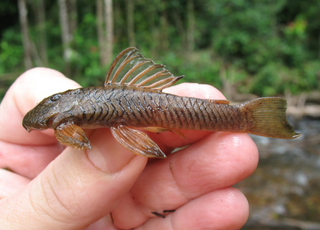
The Cetopsidae are a small family of catfishes, commonly called the whale catfishes.
This glossary of ichthyology is a list of definitions of terms and concepts used in ichthyology, the study of fishes.

Corydoras panda is a species of catfish belonging to the genus Corydoras, of the family Callichthyidae, and is a native member of the riverine fauna of South America. It is found in Peru and Ecuador, most notably in the Huanaco region, where it inhabits the Rio Aquas, the Rio Amarillae, a tributary of the Rio Pachitea, and the Rio Ucayali river system. The species was first collected by Randolph H. Richards in 1968, and was named Corydoras panda by Nijssen and Isbrücker in 1971. The specific name is an allusion to the appearance of the fish, which possesses large black patches surrounding the eyes, reminiscent of those found on the giant panda. Accordingly, the common names for this fish, which is a popular aquarium species, are panda corydoras and panda catfish.

Auchenipterichthys is a genus of driftwood catfishes found in South America.

Helogenes is a genus of whale catfish found in tropical South America.
Cetopsidium is a genus of catfishes of the family Cetopsidae.
Denticetopsis is a genus of catfishes of the family Cetopsidae.
Breitensteinia is a genus of catfishes of the family Akysidae. It includes three species.

Acrochordonichthys is a genus of catfishes of the family Akysidae. It includes ten species.

Cetopsis is a genus of catfishes of the family Cetopsidae.

Entomocorus is a genus of catfishes of the family Auchenipteridae.

Auchenipterus is a genus of driftwood catfishes.

Synodontis grandiops is a species of upside-down catfish endemic to the Democratic Republic of the Congo, Burundi, and Tanzania, where it is only known from Lake Tanganyika. It was first described by Jeremy John Wright and Lawrence M. Page in 2006, from specimens collected at multiple points along the shore of Lake Tanganyika. The species name is a Latinized combination of the Latin "grandi", meaning large or big, and the Greek "ops", meaning eye, a reference to the relatively large eyes of this fish.
Synodontis lucipinnis is a species of upside-down catfish endemic to Zambia, where it is only known from the Musende Rocks area (Mpulungu) of Lake Tanganyika. It was first described by Jeremy John Wright and Lawrence M. Page in 2006. The species name "lucipinnis" is derived from a combination of the Latin luci, meaning bright or clear, and the Latin pinnis, meaning fin. This refers to the light coloration in a patch on the base of the fins of this species.
Astyanax microschemos is a species of characid fish from Brazil. It belongs to the A. scabripinnis species complex and differs from other species outside it by having a lower number of branched anal fin rays and its shallow body depth being about 26.9-29.7 vs more than 35% of its standard length (SL). Compared to species of its own complex, it can be distinguished by the combination of its shallow body depth, and smaller interorbital width. The species name comes from the Greek mikroschemos, meaning "low stature", which refers to the shallow body depth of the animal.
Deuterodon pelecus is a species of characid fish from Brazil. It can be distinguished from other species by: its body depth ; its short and pointed snout smaller than the orbital diameter; and a reduced number of branched anal fin rays. D. pelecus also differs from members of its genus by its characteristic color pattern. It possesses a single humeral spot that is constricted to the region above the lateral line; at the same time it shows a conspicuous midlateral body stripe from opercle to the caudal fin base, an autapomorphy of this precise species. Other Deuterodon species have a humeral spot that is vertically or horizontally elongate and have the midlateral stripe becoming faint near that humeral spot. The species name is derived from the Greek pelekus, meaning "axe", referring to the pigmentation shape resulting from the adjoinment of the humeral spot with the midlateral stripe.

Guyanancistrus nassauensis is a species of catfish belonging to the family Loricariidae, the suckermouth armored catfishes. It is discovered in 2005 and formally described in 2018. G. nassauensis is a rare species, highly endemic to the Nassau Mountains in Suriname, and is threatened with extinction by proposed or ongoing mining activities.
Huigobio exilicauda is a species of cyprinid fish found in the Pearl River basin in China. All of the specimens were collected in the Pearl River basin in Guangdong Province, China, in 1976. It is sometimes considered an ambiguous synonym of Huigobio chenhsienensis. Differs from Huigobio chenhsienensis in that it has a thin caudal peduncle ; and a narrower interorbital gap than eye.
Labeo heladiva, is a species of freshwater fish in the family Cyprinidae. It is endemic to Sri Lanka. Earlier considered as the same species as Labeo dussumieri in India, recent phylogenetic and physiological differences suggest that Sri Lankan population is a distinct species.

Cetopsis candiru, also known as candiru, candiru açú, candiru cobra or canero, is a carnivorous species of whale catfish found in the Amazon basin of Peru, Brazil and Bolivia. Similar to Cetopsis coecutiens, Cetopsis candiru is a large species of the genus Cetopsis and a widespread scavenger, known for its voracious feeding and the habit of burrowing into the carcasses of dead animals and humans. Despite its name, it is not closely related to the bloodsucking Candiru.










